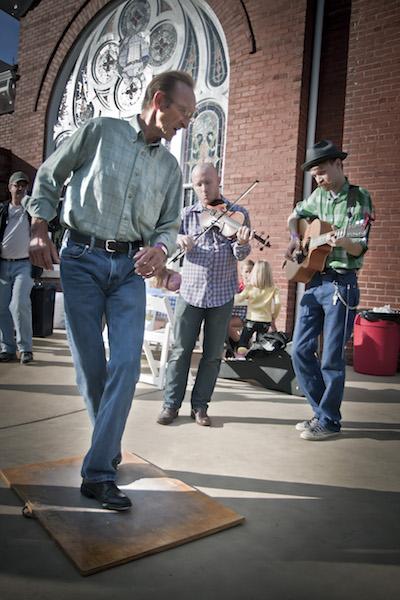#NEAHeritage Spotlight on Appalachian Percussive Dancing

Growing up in West Virginia, I attended countless county fairs, folk festivals, and square dances where a variety of dance traditions could be seen. I watched solo dancers off to the side of music jams shuffling their feet on resonant wooden dance boards. I also saw teams of dancers in flashy costumes kicking their feet up high in competitions. West Virginia University even offered clogging classes (in which I enrolled as soon as I was a college student). Later, I learned these styles of percussive dance were different yet related traditions that took hold in the Appalachian region of the United States where Anglo-American and African-American dance forms interacted over time. Clogging may be the most well-known, but it is a recent development compared to buck dancing or flat footing, the tradition 2017 NEA National Heritage Fellow Thomas Maupin carries from his parents and grandparents.
Folklorist Mike Seeger explained in his book Talking Feet that clogging is a modern blend based on the older flatfoot and buck dancing styles in the same way that modern country music is based on traditional string band music but adapted for commercial entertainment. Although flatfoot buck dancing has been practiced informally as part of everyday life in the Appalachian region for generations, clogging started to become a popular staged performance in the mid-twentieth century. So how do you tell one from the other? Read these ten key differences, and you’ll be ready to enjoy Thomas Maupin’s subtle yet joyous style of dance at the National Heritage Fellowships Concert on September 15!
1. The music that accompanies flatfoot buck dancing is usually traditional fiddle and banjo tunes or old-time music, but clogging is often performed to contemporary country, or popular music.
2. Flatfoot buck dancing is a personal response to and interpretation of the music. It’s free-form structure is improvisational and spontaneous. When Maupin teaches young dancers steps, for example, he encourages them to make the steps their own and add their own creativity to it. Cloggers, on the other hand, often rehearse choreographed routines in which they dance in unison.
3. Flatfoot buck dancing is usually performed solo, whereas clogging is often performed in teams.
4. There is no dress code for flatfoot buck dancing, but clogging teams often perform in matching showy costumes for an added visual effect.
5. Buckdancers usually learn their steps informally from family, friends, and the surrounding community. Thomas Maupin learned to dance as a child along with his brothers and sisters from parents, grandparents, and at community dances. Cloggers, however, usually seek out more formal training from classes or clubs.
6. As an oral/aural tradition, flatfoot buck dancing is learned primarily by imitation and repetition until the dancer is skilled enough to add in his or her own style and steps. Clogging can be learned by imitation but can also be learned from cue sheets or step notation.
7. Although the percussive element of flatfoot buck dancing is rhythmically intricate, the movement is subtle and mostly kept below the knees and close to the floor. Clogging, on the other hand, is focused on showmanship and precision footwork with high kicks that put the whole body in motion.
8. Although competitions abound for both styles, flatfoot buck dancing is less focused on competition, whereas clogging is a more competitive dance form. When Maupin was growing up in Tennessee learning steps from his family, there were no big competitions to practice for; dancing was just part of life and a way to have fun with family and neighbors. But as old-time music contests became common later in life, Maupin became an active competitor and has won several state, regional, and national championships.
9. Taps on the soles of dance shoes are ubiquitous for cloggers, and most use double taps. Buckdancers, however, vary on their use of taps. Some, as Maupin’s grandmother did, even dance barefoot. When dancing casually at a music jam, Maupin often wears taps on his shoes, but when dancing for flatfoot competitions, which sometimes forbid taps, he will go tap-less.
10. Because flatfoot buck dancing is learned from family or the surrounding community, it features regional steps and individual creativity, and because clogging is taught in classes and focused on competition, it features more standardized steps and terminology.
Don’t forget to tune in to the NEA National Heritage Fellowships Concert on Friday, September 15 to celebrate Thomas Maupin and all of the 2017 NEA National Heritage Fellows. Watch live on arts.gov. Going to be in the DC area? Find out how you can get free tickets to this event here.




